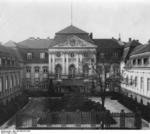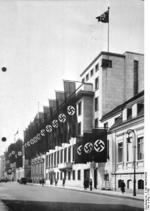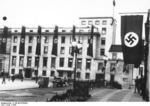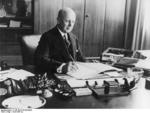Reich Chancellery
| Type | 177 Government Building | |
| Historical Name of Location | Berlin, Germany | |
| Coordinates | 52.511667000, 13.381944000 |
Contributor: C. Peter Chen
ww2dbaseIn 1875, the Rococo city palace on the street Wilhelmstra├če in Berlin, Germany belonging to the late Prince Antoni Radziwill, previously known as Palais Schulenburg, was acquired by the Prussian state government as the office for Chancellor Otto von Bismarck. The building was significantly enlarged by the addition of a southern annex, which was completed in 1930. Between 1932 and 1933, the building also served as the office of President Paul von Hindenburg, whose nearby office was undergoing a renovation. In 1935, architects Paul Troost and Leonhard Gall redesigned the interior as Adolf Hitler's residence, who had been made the chancellor in Jan 1933. They also added a large reception hall and conservatory, officially known as the Festsaal mit Wintergarten, in the garden area. The latter addition was unique because of the large cellar that led a further 1.5 meters down to an air raid shelter.
ww2dbaseIn 1935, Hitler ordered preliminary planning of a new Reich Chancellery building. The new building would become Hitler's new office, while the existing building would remain his residence. In 1937, some buildings on the northern side of the nearby street Vo├čstra├če were demolished in preparation of the new building. In late Jan 1938, Hitler officially tasked Albert Speer to design and build a new Reich Chancellery building, giving him a deadline of Jan 1939. Speer declared the construction complete 2 days prior to the deadline and received Hitler's praise, but in actuality interior fittings would continue well into the early 1940s. The construction of the new Reich Chancellery cost over 90,000,000 Reichsmark. A bunker complex, F├╝hrerbunker, was built in the garden area between the two buildings. It was connected to the existing air raid shelter by a set of stairs.
ww2dbaseBoth buildings suffered heavy damage during the war, particularly during the Battle of Berlin of 1945. The F├╝hrerbunker would become Hitler's final headquarters in the last days of the war, and the site of his eventual suicide.
ww2dbaseSoviet diplomat Andrei Gromyko (later Soviet head of state, ie. Chairman of the Presidium of the Supreme Soviet) visited the Reich Chancellery building in May 1945; he later noted:
ww2dbaseAfter the war, the Soviets embarked on an effort to demolish the entire site, which took many years to complete.
ww2dbaseSource: Wikipedia
Last Major Update: Jan 2017
Reich Chancellery Interactive Map
Photographs
 |  |  |  |
Reich Chancellery Timeline
| 30 Mar 1941 | In a lengthy speech in the Cabinet Room of the Chancellery in Berlin, Germany, Hitler told his assembled commanders of his intention to "exterminate" communism "for all time". |
| 24 Feb 1945 | Adolf Hitler made what was to be his last speech to Reischsleiters and Gauleiters in the Chancellery in Berlin, Germany. |
| 23 Apr 1945 | After sundown, Albert Speer bid his final farewell to Adolf Hitler. He admitted to Hitler that he had sabotaged Hitler's scorched earth policies, and Hitler forgave him for disobeying the order. Speer toured the Chancellery in Berlin, Germany for the last time before leaving for Hamburg, Germany. |
| 28 Apr 1945 | In Berlin, Germany, Marshal Ivan Koniev's men had virtually cleared the Potsdamer Strasse and Soviet troops were now within a mile of the Chancellery and the Reichstag, spurred on by Joseph Stalin's explicit wish that the Soviet flag should fly there in time for the May Day celebrations. In the bunker under the Chancellery, Adolf Hitler awaited reports for the progress of the counterattack he had ordered Walther Wenck to commence; he would receive no such report as he counterattack never took place. |
| 30 Apr 1945 | The recently married Adolf Hitler and Eva Braun committed suicide in Berlin, Germany. Their bodies were burned near the Chancellery bunker. |
| 1 May 1945 | Joseph Goebbels and his wife committed suicide in the garden of the Chancellery in Berlin, Germany after poisoning their six children with cyanide. |
| 4 May 1945 | Hans Fritzsche was brought to the Chancellery in Berlin, Germany to identity the body of Joseph Goebbels. |
| 5 May 1945 | SMERSH agents attached to Soviet 3rd Shock Army found two burned bodies in a bomb crater near the Chancellery in Berlin, Germany and buried them without much thinking. |
| 6 May 1945 | SMERSH agents of Soviet 3rd Shock Army sneaked into a section of Berlin, Germany occupied by a different Soviet unit to secretly retrieve two burned bodies near the Chancellery; they believed that one of them might be that of Adolf Hitler's. |
| 8 May 1945 | A special medical commission of Soviet 1st Byelorussian Front headed by Lieutenant Colonel Faust Shkaravsky performed an autopsy on the two bodies retrieved near the Chancellery in Berlin, Germany, one of which was suspected to be that of Adolf Hitler's. He noted that a part of the skull on one of the bodies was missing, but the cause of death of that person was more likely cyanide poisoning. |
| 11 May 1945 | Military medical doctor Lieutenant Colonel Faust Shkaravsky of Soviet 1st Byelorussian Front concluded that one of the two bodies Soviet SMERSH agents retrieved near the Chancellery in Berlin, Germany was that of Adolf Hitler's. |
Did you enjoy this article or find this article helpful? If so, please consider supporting us on Patreon. Even $1 per month will go a long way! Thank you. Share this article with your friends: Stay updated with WW2DB: |
| WW2-Era Place Name | Berlin, Germany |
| Lat/Long | 52.5117, 13.3819 |
- » 1,150 biographies
- » 337 events
- » 43,917 timeline entries
- » 1,241 ships
- » 350 aircraft models
- » 207 vehicle models
- » 374 weapon models
- » 123 historical documents
- » 260 facilities
- » 470 book reviews
- » 28,544 photos
- » 432 maps
Lt. Gen. Lewis B. "Chesty" Puller, at Guadalcanal
Please consider supporting us on Patreon. Even $1 a month will go a long way. Thank you!
Or, please support us by purchasing some WW2DB merchandise at TeeSpring, Thank you!